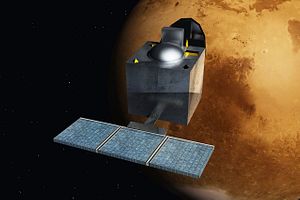India’s Mars Orbiter Mission (MOM), more commonly known by the Hindi nickname Mangalyaan (meaning Mars-craft), reached Mars early Wednesday (Indian Standard Time). The probe went into orbit around Mars after it was captured by Mars’ gravity around 7:41 a.m.
This marks the end of the spacecraft’s ten month journey, which began with its launch on November 5, 2013. Mangalyaan’s success makes India only the fourth entity to put a spacecraft in Mars’ orbit, after the United States, the Soviet Union, and the European Space Agency. India is the first Asian country to successfully place a spacecraft in orbit around Mars, and the first country anywhere to do so on its first attempt. A previous Chinese attempt to reach Mars failed in 2011.
While Mangalyaan’s primary purpose was to serve as a demonstration that India could indeed reach Mars, it will also carry out valuable scientific research. It contains a camera and four scientific instruments for the study of Mars’ surface and atmosphere. According to Space.com, a premier astronomy news website, Mangalyaan “will search for methane, a key target for researchers hunting for signs of life on Mars. Living things produce more than 90 percent of the methane in Earth’s atmosphere. And the gas is thought to disappear relatively quickly from Mars’ air, meaning that any methane spotted there would have been produced recently.”
The probe will follow a highly elliptical 77-hour orbit around Mars that will bring it as close as 365 kilometers (227 miles) to Mars at its closest and as far as 80,000 kilometers (49,710 miles) at its apogee. Mangalyaan’s mission is expected to last from between six to ten months.
Hailing the probe’s success, Indian Prime Minister Narendra Modi congratulated India’s scientists and India’s space agency, the Indian Space and Research Organization (ISRO). Modi said, “Today all of India should celebrate our scientists. Schools, colleges should applaud this. If our cricket team wins a tournament, the nation celebrates. Our scientists’ achievement is greater.”
It is notable that Mangalyaan achieved something for India that no other country has yet achieved. India is now the first country to reach Mars on its first attempt. Prime Minister Modi, who monitored the probe’s progress from its mission control center in Bangalore, said of the mission that “the odds were stacked against us. Of 51 missions attempted in world only 21 have succeeded. We have prevailed.” India’s space program has met a number of successes in the past decade, including sending up the Chandrayaan-1 lunar orbiter, which discovered key evidence of water on the moon in 2008.
Even more notable are the implications of Mangalyaan’s success for the costs of space travel. Mangalyaan cost India about $74 million, a fraction of the $671 million cost of the U.S. National Aeronautics and Space Administration’s latest Mars program. This fact led Prime Minister Modi to remark that “the amount our scientists have spent on this mission is even less than what they spend in making Hollywood movies,” referring to the American space movie Gravity, which cost around $100 million to make.
Indian frugality comes out of necessity, as India only spends $1.2 billion a year on its space program. According to The Wall Street Journal, “to hold costs down, India relied on technologies it has used before and kept the size of the payload small, at 15 kilograms. It saved on fuel by using a smaller rocket to put its spacecraft into Earth orbit first to gain enough momentum to slingshot it toward Mars.” The same article adds that “India is rapidly gaining increasing recognition worldwide as a low-cost option for sending satellites into orbit,” something which is reinforced by the success of Mangalyaan. Even taking into account India’s cheaper labor costs, Mangalyaan was extremely cost effective. Perhaps India’s approach to space will pave the way for the future rather than the exorbitant approach of the American space program. Pervasive space exploration and potential human colonization will be unlikely until the costs of space travel drop, and India seems to be at the forefront of cutting space costs. As a result, India could potentially become a future leader in the space market.

































